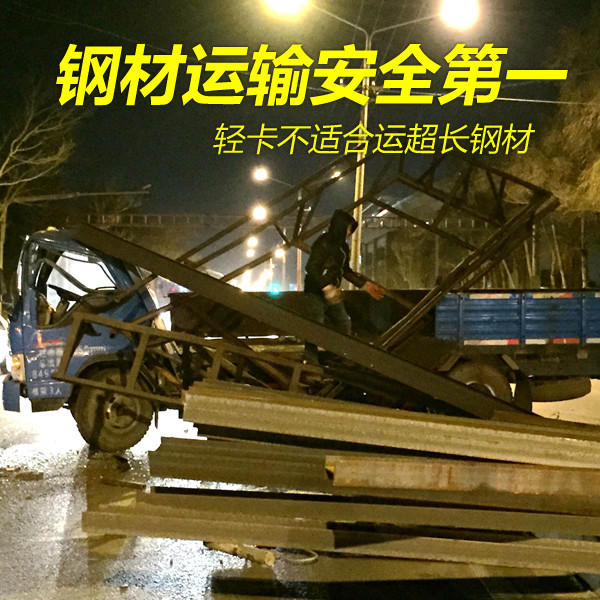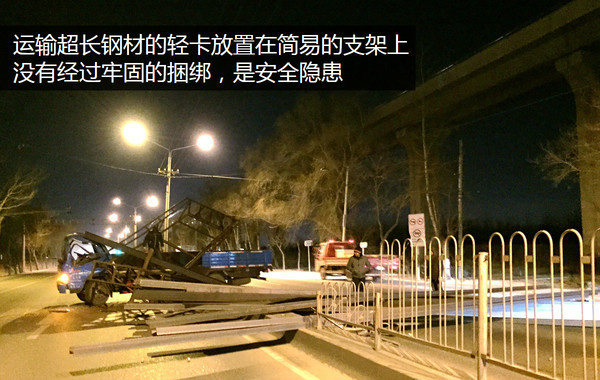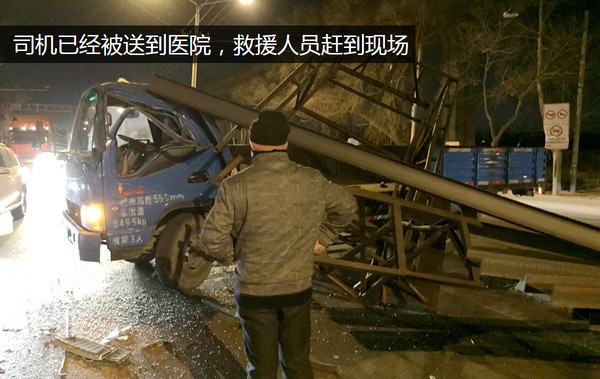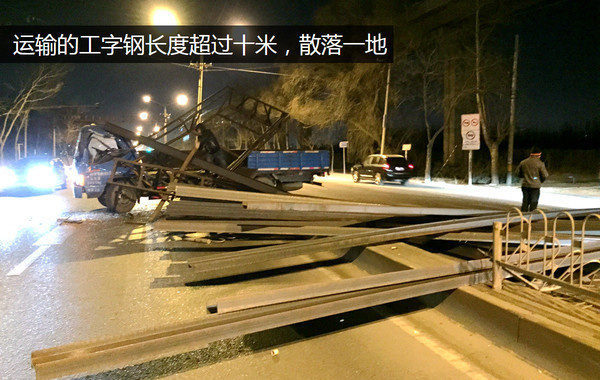Recently, Xiao Bianlu encountered an accident. Occupational sensitivity drove Xiao Bian to stop to observe the cause of the accident and the scene. Analysis for everyone to learn lessons, driving safety first. â— The reason is that the short car is not tied tightly The site is an open suburban road with two lanes and four lanes. The road conditions are good and there is no rain or snow. It was just bad light at night and the line of sight was poor. At the scene, a single-row board light truck transports long I-beam components that are more than ten meters long. More than a dozen steels are placed in light-duty containers only through simple brackets, and are not tied tightly. This is a great safety hazard. This type of transportation has poor cornering stability. The driver should try to transport the goods to the urban area at night when the traffic flow is small. After the accident, the site was littered with cargo and crashed supports, and fragments of car glass were also scattered. From this point of view, the occupant space of the cab is still there, and the driver should have no serious problems and have been sent to the hospital. â— The rescue staff is not professional and is prone to secondary injury Xiao Bian saw that the scene was more messy. Rescue workers pass the steel by hand, and there are no warning signs such as reflective tripods on both ends of the road. This is dangerous. Rescue workers were unable to do anything before the rescue machines such as cranes arrived on the scene. The first thing that should be done is to place warning signs around roads to avoid affecting other normal driving vehicles. The light truck chassis is small and the wheelbase is short. When such a long cargo is transported, the front and rear of the vehicle must be left unconnected for a long period of time. This is a great security risk. The light truck has low power and the braking effect is poor. The goods are placed in suspension, and the goods are easily moved forward during sudden braking. â— Postscript: Extra-long or extra-wide goods should still be transported by vehicles of corresponding length. In order to save freight and use light trucks to transport long steel products, it is hard to save money. In case of an accident, it will waste more money and time. It also compensates for the loss of public facilities such as guardrails. This is really a painful lesson.
Tiltrotator testing is the process of evaluating the performance, functionality, and safety of a tiltrotator attachment used in construction equipment, such as excavators. A tiltrotator is a hydraulic attachment that allows the operator to rotate and tilt the bucket or other attachments, providing increased flexibility and efficiency in various construction tasks.
An excavator attachment is a tool or accessory that can be attached to an excavator to enhance its functionality and performance. These attachments are designed to perform specific tasks and can be easily attached and detached from the excavator, depending on the job requirements. Some common excavator attachments include:
Mini Excavator Attachments,Excavator Price,Excavator Attachments For Sale,Excavator Attachments CATSU Hydraulic Machinery Equipment Co.,Ltd , https://www.tiltrotatorcat.com




During tiltrotator testing, various aspects are assessed, including:
1. Rotation and tilt capabilities: The attachment's ability to rotate and tilt smoothly and accurately is evaluated. This involves testing the range of motion, speed, and precision of the tiltrotator.
2. Load capacity: The attachment's load-bearing capacity is tested to ensure it can handle the specified weight limits. This involves subjecting the tiltrotator to various loads and evaluating its performance under different conditions.
3. Hydraulic system performance: The hydraulic system responsible for controlling the tiltrotator's movements is tested for efficiency and reliability. This includes assessing the responsiveness of the hydraulic controls and evaluating any potential leaks or malfunctions.
4. Safety features: The tiltrotator's safety features, such as overload protection, emergency stop mechanisms, and locking mechanisms, are tested to ensure they function properly and provide adequate protection for the operator and surrounding personnel.
5. Durability and endurance: The attachment is subjected to rigorous testing to evaluate its durability and endurance under real-world construction conditions. This involves simulating various work scenarios and assessing the tiltrotator's ability to withstand wear, tear, and potential damage.
6. Compatibility and integration: Tiltrotators are designed to be compatible with specific excavators or other construction equipment. Testing involves verifying the attachment's compatibility with the designated machinery and assessing its integration and ease of installation.
Tiltrotator testing is crucial to ensure the attachment meets performance standards, adheres to safety regulations, and functions reliably in construction applications. It helps identify any design flaws, manufacturing defects, or operational issues that need to be addressed before the tiltrotator is used in the field.
1. Bucket – used for digging and moving materials
2. Grapple – used for picking up and moving large objects
3. Auger – used for drilling holes
4. Hammer – used for breaking rocks and concrete
5. Ripper – used for breaking up hard soil or rock
6. Shears – used for cutting through metal or concrete
7. Tiltrotator – used for rotating and tilting the bucket for more precise digging
8. Thumb – used for gripping and holding objects
9. Rake – used for clearing and leveling land
10. Compactor – used for compacting soil or other materials.